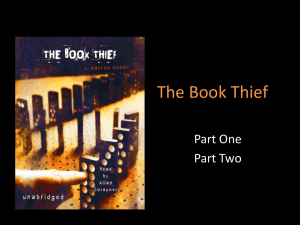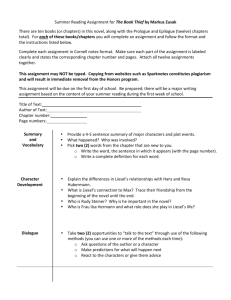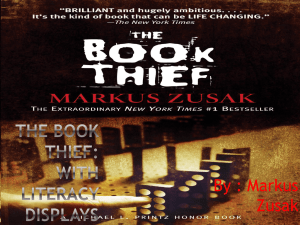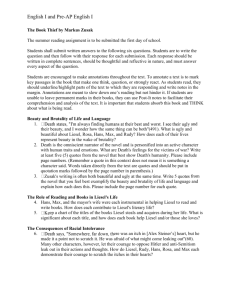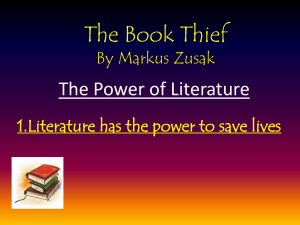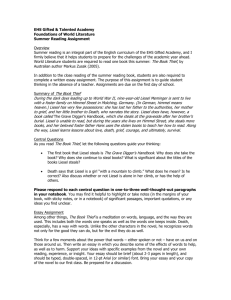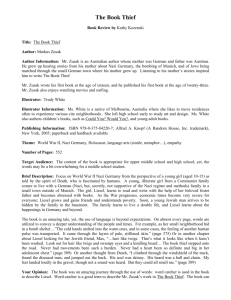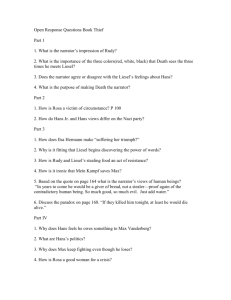The Book Thief: Symbolism, Imagery & Allegory Analysis
advertisement
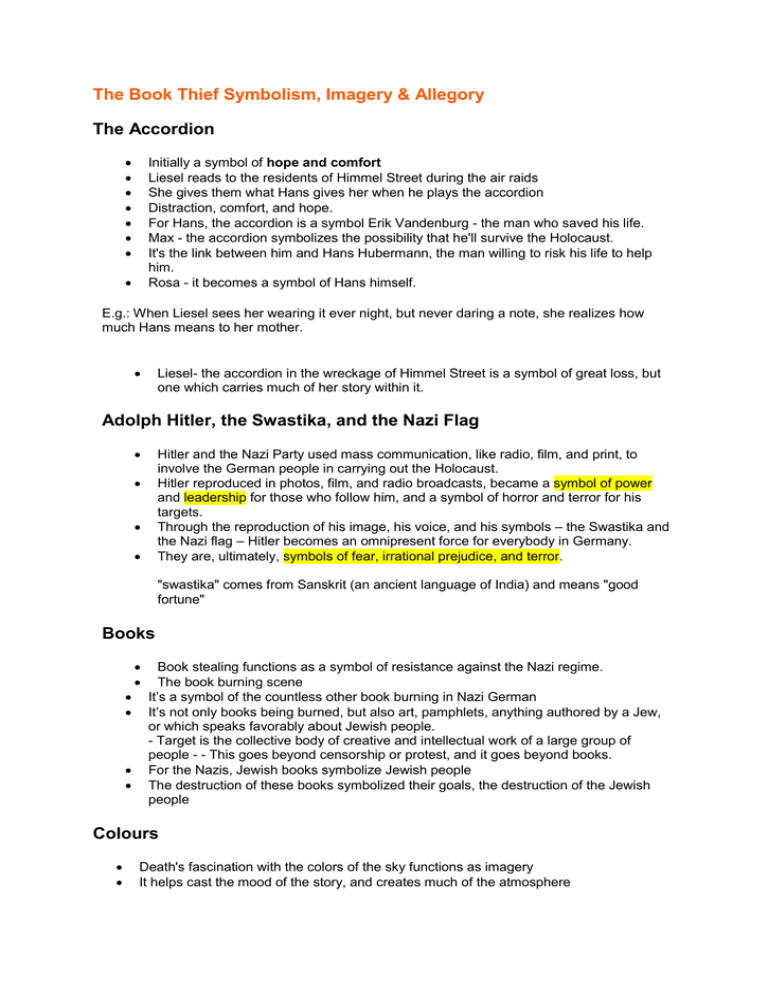
The Book Thief Symbolism, Imagery & Allegory The Accordion Initially a symbol of hope and comfort Liesel reads to the residents of Himmel Street during the air raids She gives them what Hans gives her when he plays the accordion Distraction, comfort, and hope. For Hans, the accordion is a symbol Erik Vandenburg - the man who saved his life. Max - the accordion symbolizes the possibility that he'll survive the Holocaust. It's the link between him and Hans Hubermann, the man willing to risk his life to help him. Rosa - it becomes a symbol of Hans himself. E.g.: When Liesel sees her wearing it ever night, but never daring a note, she realizes how much Hans means to her mother. Liesel- the accordion in the wreckage of Himmel Street is a symbol of great loss, but one which carries much of her story within it. Adolph Hitler, the Swastika, and the Nazi Flag Hitler and the Nazi Party used mass communication, like radio, film, and print, to involve the German people in carrying out the Holocaust. Hitler reproduced in photos, film, and radio broadcasts, became a symbol of power and leadership for those who follow him, and a symbol of horror and terror for his targets. Through the reproduction of his image, his voice, and his symbols – the Swastika and the Nazi flag – Hitler becomes an omnipresent force for everybody in Germany. They are, ultimately, symbols of fear, irrational prejudice, and terror. "swastika" comes from Sanskrit (an ancient language of India) and means "good fortune" Books Book stealing functions as a symbol of resistance against the Nazi regime. The book burning scene It’s a symbol of the countless other book burning in Nazi German It’s not only books being burned, but also art, pamphlets, anything authored by a Jew, or which speaks favorably about Jewish people. - Target is the collective body of creative and intellectual work of a large group of people - - This goes beyond censorship or protest, and it goes beyond books. For the Nazis, Jewish books symbolize Jewish people The destruction of these books symbolized their goals, the destruction of the Jewish people Colours Death's fascination with the colors of the sky functions as imagery It helps cast the mood of the story, and creates much of the atmosphere By focusing on the sky-colors at the times of human deaths, Death suggests that there is a connection between a person's death and the natural world The idea that each person dies with their own color of sky presents a vision of a universe which cares about humans, and isn't indifferent to them Laws and Propaganda of Nazi Germany Laws and propaganda set the mood of the times 1933 (when the Nazi Party took power) to 1939 (when the war began), the Nazis issued thousands of laws restricting every aspect of Jewish life Jews being required to wear yellow stars to identify themselves as Jewish Jews were barred from government jobs, from being teachers, from attending school, from practicing their professions, from joining the military, from admission to hospitals, and from living among non-Jewish people The Nuremburg Laws stripped Jewish people of their German citizenship and their right to vote, yet barred them from leaving the country. Laws authorized the confiscation of all Jewish property, the arrest, detention and torture of Jews in concentration camps, and, ultimately, the large scale murder of Jewish people. Hitler and the Nazi Party used mass communication technology – radio, film, and print material – to involve the German people in carrying out the Holocaust. In this propaganda, Jews and other groups were spoken of in dehumanizing terms, referred to as vermin, cockroaches, as "a world plague," and represented as dangerous to society. Nazi propaganda used specific euphemisms A euphemism is "an inoffensive or indirect expression that is substituted for one that is considered offensive or too harsh", (can be used to humour or to offend). Nazis used words like "cleansing," "evacuation," "resettlement," "special treatment," and "extermination" “final solution” to refer to the murder of Jewish people Basements There are two basements in the novel, both on Himmel Street. both basements are places to hide Both stressing the culture of fear Max (Jews), if they are 'lucky,' are hiding from the Nazis in basements German citizens, like the residents of Himmel Street, are hiding from the Allies' air raids Basements are cold, uncomfortable and cramped Life in the basement is uncertain. Each breath might be your last. They are only temporary There is a fine line between safety and danger in these basements. The Hubermann house The basement is where Liesel and Max forge their friendship where Liesel learns to read where Max writes his books Where Rosa, Hans, and Liesel have their snowball fight. There is love in the Hubermanns' basement. The house of the Fielders basement/bomb shelter Liesel realizes that she can use her love of reading to provide much needed comfort to those around her Liesel becomes "the word shaker," when she begins reading to her friends and neighbours Later, the basement becomes a seat of creativity for Liesel as she writes her life story, as it was for Max when he wrote The Word Shaker. Symbolism of Basement: Creativity and artistic expression are often believed to come from the subconscious, that place under the surface of our conscious thoughts Basements are being used to help draw the mood of the story, but also to highlight the creativity of characters like Liesel and Max. Liesel and Max are creative, loving people in spite of their circumstances, not because of them. They did not need to be locked in a basement to do creative work. At the same time, deep suffering and knowing they could die at any moment adds urgency and power to their work. This is irony Desperately Hopeful The novel focuses on characters in very dark and difficult situations Death is hoping to "to prove to [himself] that you, and your human existence, are worth it" (4.33) The novel offers glimmers of hope The characters of the novel do despair, but always manage to rise again with renewed courage The novel makes readers want to believe that humans can grow, learn, and change The tone of the narrator suggests that a world without fear and hatred that led to the Holocaust may be a long way off The characters in the novel inspire readers to take a stand against injustice whenever opportunities to do so present themselves. The Book Thief Writing Style Foreshadowing, Spoiling, Illustrated, A Book-Within-A Book-Within a Book Foreshadowing is a literary technique in which events that occur later in a story are hinted at in advance. The narrator Death reveals when certain characters die and under what circumstances. In the prologue, Death explains that the novel will include, among other things, "a girl" (Liesel), "an accordionist" (Hans), and "a Jewish fist fighter" (Max) Death describes Liesel as a "perpetual survivor," indicating that she lives through the war while others around her die. The This technique keeps the reader's focus on the actual processes by which the characters meet their ends and emphasizes the futility of the characters' individual actions in the face of an all-consuming war. Death's use of boldface text to relay certain information, as here: *** A SMALL ANNOUNCEMENT*** ABOUT RUDY STEINER He didn't deserve to die the way he did. (37.9). Death's favourite pastimes: foreshadowing and plot-spoiling The foreshadowing of the other events makes us let down our guards and be surprised. Death also provides illustrations, books within his books, The Standover Man and The Word Shaker, both written on painted-over pages of Adolph Hitler's Book, Mein Kampf. There are excerpts from the other books that are important to Liesel. This includes her own book, The Book Thief, the story of her life, which Death rescues from a trash truck and reads over and over again before returning it to her when she dies. Title Symbolism The title most obviously refers to Liesel Meminger, the book thief of the story She's officially given the title by her best friend Rudy Steiner at the end of Chapter 42. In this chapter, Liesel steals The Whistler from Ilsa Hermann's library, the first of many such library raids. Death, is also a book thief - When Liesel drops her newly completed memoir, The Book Thief, after learning that all those she knows and loves on Himmel Street have died from bomb blasts, Death steals the book from a trash truck. Max Vandenburg, the Jewish man hiding from the Nazis, who commits an ultimate act of figurative book thievery. He paints the pages of Adolph Hitler's book, Mein Kampf, white and then sketches loving and frightening words and pictures of his life over the paint. Hitler is actually the biggest book thief of the novel. This becomes apparent in Part 2, which features a massive book burning in celebration of Hitler's birthday in 1940. With every act of book-thievery, Liesel and her crew steal back whatever words and books they can from Hitler, and even steal his book from him (though he doesn't know it!). Liesel dreams of Hitler and his glowing stream of words coming from his mouth. - Triggered by her brother’s death - She was attracted to Hitler’s oratory - She comes to understand through books, the horror of his words - Juxtaposition: Hitler attacks Jews and talks of hatred with Liesel’s brother dying while fleeing persecution and poverty
